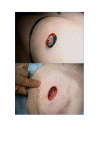Oncological considerations of skin-sparing mastectomy
- PMID: 16725046
- PMCID: PMC1481515
- DOI: 10.1186/1477-7800-3-14
Oncological considerations of skin-sparing mastectomy
Abstract
Aim: To review evidence concerning the oncological safety of performing skin-sparing mastectomy (SSM) for invasive breast cancer and ductal carcinoma in situ (DCIS). Furthermore, the evidence concerning RT in relation to SSM and the possibility of nipple preservation was considered.
Methods: Literature review facilitated by Medline and PubMed databases.
Findings: Despite the lack of randomised controlled trials, SSM has become an accepted procedure in women undergoing mastectomy and immediate reconstruction for early breast cancer. Compared to non-skin-sparing mastectomy (NSSM), SSM seems to be oncologically safe in patients undergoing mastectomy for invasive tumours smaller than 5 cm, multicentric tumours, DCIS or risk-reduction. However, the technique should be avoided in patients with inflammatory breast cancer or in those with extensive tumour involvement of the skin in view of the high risk of local recurrence. SSM with nipple areola complex (NAC) preservation appears to be oncologically safe, provided the tumour is not close to the nipple and a frozen section protocol for the retro-areolar tissue is followed. Although radiotherapy (RT) does not represent a contraindication to SSM, the latter should be used with caution if postoperative RT is likely, since it detracts from the final cosmetic outcome.
Figures



Similar articles
-
Oncological and aesthetic considerations of skin-sparing mastectomy.Breast Cancer Res Treat. 2008 Oct;111(3):391-403. doi: 10.1007/s10549-007-9801-7. Epub 2007 Oct 28. Breast Cancer Res Treat. 2008. PMID: 17965954 Review.
-
Nipple skin-sparing mastectomy is feasible for advanced disease.Ann Surg Oncol. 2013 Oct;20(10):3294-302. doi: 10.1245/s10434-013-3174-4. Epub 2013 Aug 22. Ann Surg Oncol. 2013. PMID: 23975304
-
[Skin-sparing mastectomy: an alternative to conventional mastectomy in breast cancer].Cir Esp. 2008 Oct;84(4):181-7. doi: 10.1016/s0009-739x(08)72617-4. Cir Esp. 2008. PMID: 18928767 Review. Spanish.
-
Evolving role of skin sparing mastectomy.World J Clin Oncol. 2014 May 10;5(2):33-5. doi: 10.5306/wjco.v5.i2.33. World J Clin Oncol. 2014. PMID: 24829848 Free PMC article.
-
Nipple-sparing and skin-sparing mastectomy: Review of aims, oncological safety and contraindications.Breast. 2017 Aug;34 Suppl 1(Suppl 1):S82-S84. doi: 10.1016/j.breast.2017.06.034. Epub 2017 Jun 30. Breast. 2017. PMID: 28673535 Free PMC article. Review.
Cited by
-
Inframammary fold approach in breast conserving surgery for cancer.Updates Surg. 2011 Dec;63(4):283-6. doi: 10.1007/s13304-011-0114-3. Epub 2011 Oct 13. Updates Surg. 2011. PMID: 21994071
-
A single institution experience with skin sparing mastectomy and immediate breast reconstruction.Ann R Coll Surg Engl. 2012 May;94(4):286. doi: 10.1308/rcsann.2012.286. Ann R Coll Surg Engl. 2012. PMID: 22613321 Free PMC article. No abstract available.
-
Nipple-areola-complex sparing mastectomy: five years of experience in a single centre.Updates Surg. 2013 Dec;65(4):289-94. doi: 10.1007/s13304-013-0226-z. Epub 2013 Jul 26. Updates Surg. 2013. PMID: 23888375
-
Skin-sparing mastectomy and radiotherapy: an update.Int Semin Surg Oncol. 2006 Oct 17;3:35. doi: 10.1186/1477-7800-3-35. Int Semin Surg Oncol. 2006. PMID: 17044923 Free PMC article.
-
Nipple-Sparing Mastectomy - Extended Indications and Limitations.Breast Care (Basel). 2010 Aug;5(4):253-258. doi: 10.1159/000318186. Epub 2010 Aug 6. Breast Care (Basel). 2010. PMID: 22590446 Free PMC article.
References
-
- Toth BA, Forley BG, Calabria R. Retrospective study of the skin-sparing mastectomy in breast reconstruction. Plast Reconstr Surg. 1999;104:77–84. - PubMed
LinkOut - more resources
Full Text Sources

